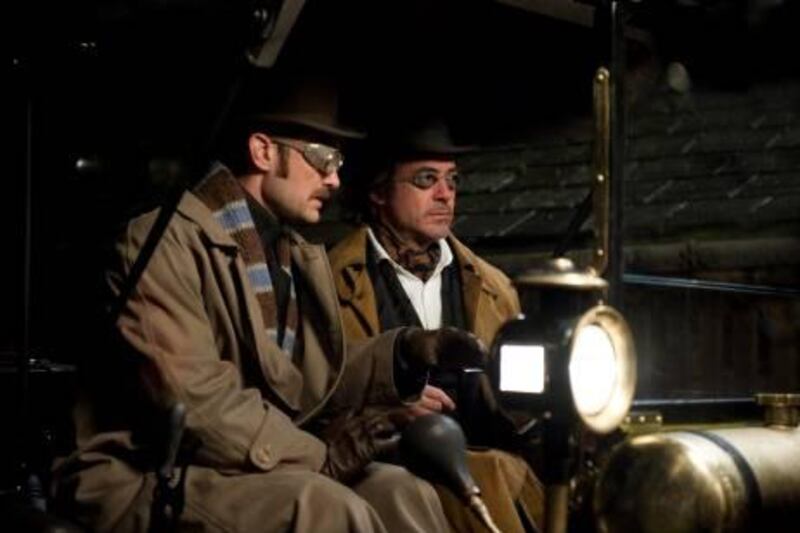With more than 70 actors having played Sherlock Holmes in more than 200 films and television series, the fictitious detective has been reinvented so many times he makes the ever-changing James Bond look like a paragon of consistency. But rarely has the breadth of the possible interpretations of Arthur Conan Doyle's character been more evident than it is today. Audiences currently have their pick of two wildly successful and critically praised Holmeses - and they could hardly be more different.
Returning to cinemas tomorrow in Sherlock Holmes: A Game of Shadows is the Hollywood star Robert Downey Jr, who plays the sleuth as a dysfunctional brainbox with a flair for fist-fighting. And reappearing on the small screen over the coming weeks in the BBC's Sherlock is the British actor Benedict Cumberbatch, whose 21st-century Holmes describes himself as a "high-functioning sociopath". The former version has giant set pieces, explosions and cross-dressing, while the latter has forensic science, Routemaster buses and text messages.
"So far as people like me are concerned, if you can reinvent [Sherlock Holmes] and do so properly - with interesting allusions to the original stories - it's a wonderful thing," says Nick Utechin, a former editor of the Sherlock Holmes Journal. "These two versions now are radically different. I think they're not to be compared."
Certain elements of the character are present throughout Conan Doyle's four novels and 56 short stories on his exploits - his brilliant powers of deduction, his companionship with Dr Watson and his address (221B Baker Street) - but almost everything else is open for reinterpretation. What's more, many of the best-known Holmes tropes actually have nothing to do with the original writing. The iconic deerstalker hat was the creation of the illustrator Sidney Paget, the curved calabash pipe was a prop used by the stage actor William Gillette, and even the supposed catchphrase, "elementary, my dear Watson", never appeared in print.
What's more, many of the elements of Downey's Holmes that seem the most egregious - his hand-to-hand combat skills, for example - are in fact directly supported in Conan Doyle's writing. "In a story called The Adventure of the Solitary Cyclist, he talks about delivering 'a straight left against a slogging ruffian', then in The Sign of Four he is described as a bare-knuckle fighter," says Utechin. "He also knows about stick fighting and, in The Final Problem, he talks about baritsu, a Japanese form of wrestling."
The eccentric personalities of both Downey's and Cumberbatch's interpretations of Holmes also sit awkwardly with some people. However, the detective was once described by Watson as "bohemian", used cocaine, was prone to starving himself and kept his tobacco in the toe-end of a Persian slipper.
His less noble traits were downplayed in films, plays and radio productions from the early 20th century. Perhaps the most enduring Holmes actor, Basil Rathbone - who donned the deerstalker in 14 US big-screen productions from 1939 to 1946 - played up the character's fastidious and heroic qualities, while Watson (Nigel Bruce) became a bumbling oaf.
Decades before Rathbone, however, the detective's first appearance on film is believed to have been in 1900's 30-second US-produced Sherlock Holmes Baffled. By the end of the silent era, dozens of Holmes movies had appeared, made by studios in the US, UK and even Denmark. With the advent of sound came a slew of big-screen Holmeses, played by the likes of Raymond Massey and Arthur Wontner.
During the Second World War, Conan Doyle's character became a propaganda tool under Rathbone. Now inhabiting wartime rather than Victorian/Edwardian London, the sleuth would quote Winston Churchill and have adventures with anti-Nazi themes. While that might have raised some eyebrows, Conan Doyle himself painted Holmes as a patriot who often acted on behalf of the British government and even carried out counter-intelligence work in the short story His Last Bow, set during the First World War.
His dysfunctional tendencies finally made it on to film in 1970's The Private Life of Sherlock Holmes, directed and co-written by Billy Wilder (Some Like It Hot). The melancholy comedy used the tagline, "What you don't know about Sherlock Holmes has made a great picture", and even implied that the detective (played by Robert Stephens) had fallen in love with Watson. Critics praised the film for its novel approach, but it was not a major box-office success.
Although the 20th century boasted many other notable Holmeses - not least Peter Cushing in the 1959 Hammer Films production - the fingerprints of Wilder's eccentric film can be seen in both Downey's and Cumberbatch's iterations. That, at least, is something they have in common.





